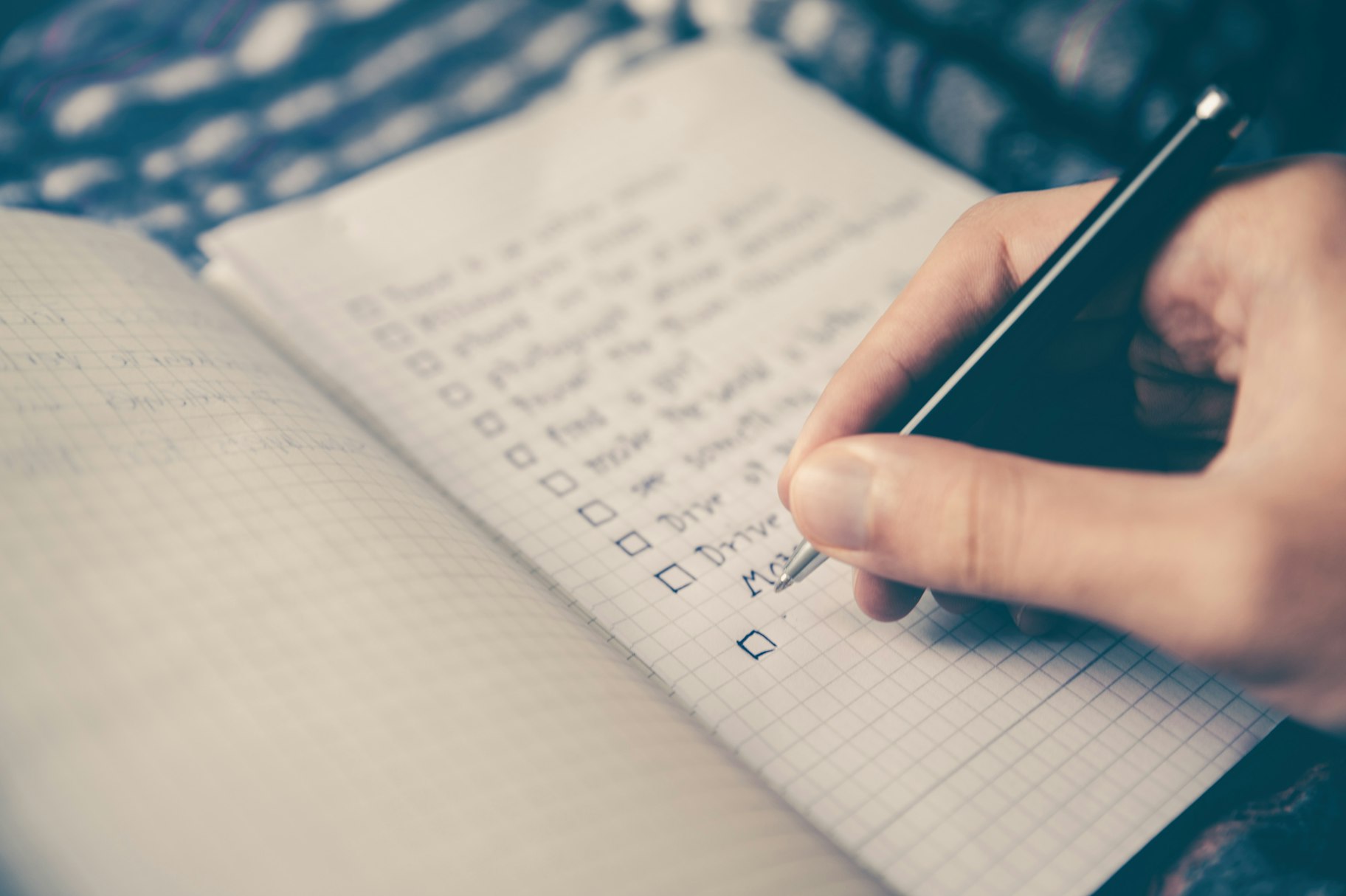The process of building an online store can be confusing, especially when you’re a beginner. You might not know what to do first. And so you do a little bit of everything in a random order. Unfortunately, this might result in some missed steps. To make sure you’re set up for success, we’ve created this ecommerce checklist for new store owners.
Ecommerce Checklist for New Store Owners
Step 1: The Idea
Most people think that the journey of starting an online store first starts when they sign up for Shopify. But successful online stores take a few earlier steps to help them achieve long-term success. The idea stage isn’t simply about having an idea and executing on it, it’s about building a foundation. Here are a few ideas for your ecommerce checklist:
- Create a list of SMART goals
- Get familiar with ecommerce terms
- Determine your store niche
- Narrow down your target audience
- Compile a list of competitors
- Use the Business Name Generator to find and buy a great domain name

- Set up social media accounts
- Start posting relevant niche content on social
- Sign up for an ecommerce platform (we recommend Shopify)
Step 2: Store Set Up
After the idea comes the execution. Setting up your Shopify store doesn’t take that much time to complete, but it’s important to finish all the steps so your website looks like a professional online store. Plus, there are a few really key things on this list – like setting up your payment details, which help you get paid (so they’re a pretty big deal!). Here’s some of the store set-up tasks you’ll want to cross off your ecommerce checklist:
- Under the “General” section, add your store details
- Add your store address
- Change your Store Currency

- In Payment Providers, Set up Shopify Payments
- Set up PayPal
- Set up other payment gateways for your country
- Create a logo for free with Oberlo’s Logo Maker
- In Checkout, customize your checkout process

- Set up customer accounts
- Fill out Order Processing details such as what to do after orders, adding address autocomplete, etc.
- Set up Abandoned Cart emails

- Change your Checkout page language, if necessary
- Under Taxes, set up taxes for your country and the rest of the world if applicable
- Customize Customer Notifications under Notifications

- Add Sales Channels as needed
- Under Billing, add a credit card
- Under Legal, copy the templates to create a Refund Policy page, Privacy Policy page, and a Terms of Service page
- Under “Pages,” add a page, then create a Contact Us page by selecting “page.contact” under “Template Suffix” on the right hand side
- Under “Collections,” create all the product collections for your store. For example, if you run a women’s fashion store, your collections list might include: Clothing, Dresses, Tops, Bottoms, Footwear, Trends, Sale
- Add your Collections to the “Main menu” under Navigation
- Under “Discounts,” create custom discount codes to entice sales for future ads
Thinking of starting a Shopify Store?
Bring your business online with Shopify, the most powerful ecommerce platform out there
Start a free Trial todayStep 3: Oberlo Set Up
Installing Oberlo on your store allows you to find products that you can start selling the same day but without having to buy inventory upfront. As Oberlo is the most popular product sourcing app in the Shopify App Store – and because, you know, we are Oberlo – we’ve decided to break down the process of setting up Oberlo as well. Here’s everything on your ecommerce checklist to do next if you’re an Oberlo user:
- Go to Apps, and install Oberlo. This will automatically connect your Oberlo account to your Shopify account

- Install the Oberlo Chrome extension for AliExpress

- Under Settings, check “Set new products as published”
- Select “Notify customers” and add “http://www.17track.net/?nums=” in the “Add custom shipping tracking URL” box

- Under “Auto updates,” select all the boxes to get notified about changes in product availability, variants, and prices
- Under “Global Pricing Rules,” you can either set a multiplier on product cost or set advanced rules if your product prices have a bigger range to them (such as $10 to $50). Don’t forget to take shipping costs into account so you can offer customers “free” shipping
- If want your product prices to be consistent, even with a pricing rule, assign cents such as .00 or .99

- Under suppliers, add a custom note such as, “I’m dropshipping. Please DO NOT put any invoices, QR codes, promotions or your brand name logo in the shipments. Please ship as soon as possible for repeat business. Thank you!”
- Under Reporting, select the frequency of reporting you’d like to receive via email
- Browse products in your niche and import them to your store

- Add up to 500 products on Oberlo’s free Starter plan
- Change the title of all your products
- Add all your products to their corresponding collection
- Include the type and tags for each product
- Write a product description and remove irrelevant or unnecessary bullet points
- Select the variants you want to have on your store
- Double check the prices for each individual product and make changes as needed
- Select the images you want displayed on your website
- Split product variants in the event you want each style as its own product (optional)

- Import each product to your Shopify store
Step 4: Theme Tweaks
When you sign up for Shopify, your store has a free theme called Debut already installed on it. If you’re just starting out and on a tight budget, you can keep and make modifications to your free theme to make it look great. Of course, if you have a different vision for your store, you can choose a different theme. There are several other free Shopify themes to choose from, or you can go with one of the 61 paid themes. Here’s the ecommerce checklist for enhancing a theme:
- View demos of your website with different themes
- Browse through the entire collection of themes within your budget (free or paid)
- Stick with or choose a new theme for your store
- Install a new theme on your store (optional)
- Customize theme
- In “Sections,” under Header, upload a .png file of your logo (so that the background is removed) and adjust the size using the slider

- Under “Menu,” select main menu for the top header
- Under announcement bar, you can either hide the announcement or add a custom announcement using the Debut theme
- Click on “Add section,” you can add any of the following though having only a select few is typically a better user experience:
- Under “Image with text overlay,” upload a relevant stock photo under Change and select the “Free images” tab searching a relevant keyword from your niche. If the size isn’t optimal or is cut off, you can download free stock images from Burst and edit down the size of photo to make it fit
- Under “Featured collections,” you can select the number of featured images you want to have showing
- Browse “Blog posts” where you can add blog posts to your homepage and choose how many you want displayed
- You can also add “Collections” to your homepage so people can view by specific collections. This can be different than your Main menu headers. For example, a collection might be “Plaid,” showcasing all your plaid styles for your women’s fashion store
- Under “Featured Collection,” you can highlight a few products on your homepage to help entice the sale when people land on that page
- Press “Gallery” to add professional photography or influencer photos to your homepage. You can also add the corresponding product link for those pictures
- For “Image with text” you can call out your best-selling product, showcasing an image and some sales copy to help promote the product
- Click “Image with text overlay,” you can add an image with text on top of it
- Under “Logo list,” you can add logos. You’d use this if you have a personal brand and wanted to show who you’ve worked with or if you have sponsors for an event
- Under “Slideshow,” you can add a slider of rotating banner images
- Under “Featured Product” you can add your best-selling product with an add to cart button so people can buy direction from your homepage
- View “Newsletter” where you can add a subscribe button to help you collect emails so you can remarket to customers
- Under “Map,” you can add a map of your store in the event that you also have a physical location

- Next, click “Rich text,” you can add standalone text to your website. This could be a brief paragraph about your brand, a mission statement, or a short about us.
- View “Testimonials” where you can add customer feedback from emails, product reviews, or social media comments to your website
- Under “Text columns with images,” you can add a heading, text, button and/or link with an image above it
- Under “Custom content,” you can add an image and text to your homepage
- Customize your Footer
- Under “Text,” you can add a brief sentence about what your online store is.
- Under “Newsletter,” sign-up you can add an email subscription form. Use this article to help you figure out what your copy should be
- Under “Menu,” you can add your store policies: privacy, refund, terms of service, and customer contact page
- Customize Theme Settings
- Select the “Colors” for your website
- Choose the “Typography,” or font your store’s text will be in
- Under “Social accounts” in the “Social Media” section add the social media URLs for your brand
- Under “Favicon,” add a favicon which is just a small graphic this could be the design without the text in your logo
- Customize the visual elements of the “Checkout” section such as images, colors, logo placement, and typography
The Final Steps
Okay, so you’re almost ready to launch your ecommerce store for the first time. But now, as you get ready to complete those finishing touches, these last steps will help you finish your ecommerce checklist to make sure your website is ready for its grand debut. Here are a few final steps for your ecommerce checklist:
- Add security badges to all of your product pages
- Create an FAQ page answering common questions about shipping times, account registration, payment methods, modifying orders, order status, returns, etc.
- Test your website on different monitors: desktop, phone, and tablet
- Remove the password protection on your store by unchecking “Enable password”

- Test the checkout process before you run your first ad
- Pay for your Shopify plan after your two-week trial
Conclusion
You might be a little overwhelmed by this really long ecommerce checklist. And that’s a normal feeling. Many new entrepreneurs do feel like they’re in over their heads when they start out. However, half the battle is knowing what to do. I hope that knowing every single step you’ll have to take over these first few months helps you inch closer to achieving the success that you dream of. And that this list actually makes you realize that you can do this. Because honestly, you’re a rockstar and you know this. It’s going to be a busy few months as you build up that new online store, but with our checklist, you can just cross things off to see how far you’ve come.
Want to Learn More?
- I Added 423 Products to Oberlo. Here’s How I Managed the Volume.
- 12 Things I Wish I Knew When I Started Dropshipping
- 100+ Best Products to Sell in 2021
- 50 Ways to Get Sales With Dropshipping




